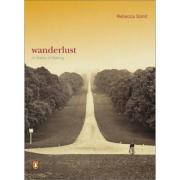by Rebecca Solnit -- Viking (Penguin Group), New York, NY. 2000 (first edition hardcover)
Author
Rebecca Solnit, author of A Book of Migrations, Savage Dreams, and Secret Exhibition, has written about visual art, public space, landscape, and environmental issues for magazines and for museums ranging from New York’s Whitney to the Denver Art Museum. She lives in San Francisco.
Blurbs
“Walking, as Thoreau said and Solnit elegantly demonstrates, inevitably leads to other subjects. This pleasing and enlightening history of pedestrianism unfolds like a walking conversation with a particularly well-informed companion with wide-ranging interests. Walking, says Solnit, is the state in which the mind, the body and the world are aligned; thus she begins with the long historical association between walking and philosophizing. Solnit's focus isn't pedestrianism's past but its prognosis--the way in which the culture of walking has evolved out of the disembodiment of everyday life resulting from "automobilization and suburbanization." Familiar as that message sounds, Solnit delivers it without the usual ecological and ideological pieties. Her book captures, in the ease and cadences of its prose, the rhythms of a good walk. The relationship between walking and thought and its expression in words is the underlying theme to which she repeatedly returns. "Language is like a road," she writes; "it cannot be perceived all at once because it unfolds in time, whether heard or read.” -- Publisher’s Weekly. Copyright 2000 Reed Business Information, Inc.
Aristotle walked while he thought, earning his school of philosophy the name "peripatetic." Social activists marched on Washington, walking in defiance of injustice and oppression. The religious faithful still make pilgrimages by walking to holy shrines, a ritual phenomenon crossing all denominational and dogmatic lines. Solnit presents an absolutely fascinating look at how the act of walking itself has influenced our history, our science, our literature, and the very way that we see ourselves as human beings. Drawing on a multitude of diverse disciplines, Solnit illustrates that walking has led to some of the best, and worst, incidents in all of history. She examines why, for instance, Britain has devoted a large portion of its infrastructure development to maintaining well-manicured walking paths throughout the country. She investigates the social cohesion existing among city dwellers who prowl through their urban landscapes, day and night, and she delves into suburban angst and ennui, linking it to the dearth of walkable public spaces. -- Booklist – Michael Spinella
Why Read It So you thought being a pedestrian was a “mode of travel” – sort of like SOV but slower? When we stop being pedestrians we become less human, less capable and less independent. When we sacrifice walking environments to commercial expediency we lose much more than our physical health and personal well-being.


